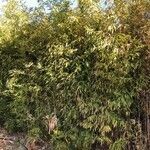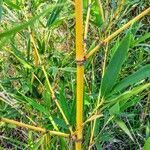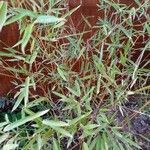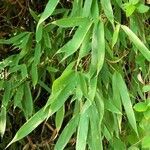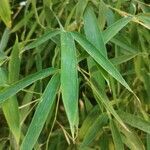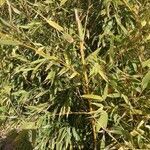Fairly dense thicket-forming with rhizomes running extensively. Culm usually 3-6 m (often taller in cultivation), glaucous when young, green during the first year, yellow afterwards, erect, with white waxy ring beneath nodes when young; nodes on some shoots congested and sometimes zigzag towards base; internodes swollen and often asymmetric. Culm-sheath light mauve-brown or pinkish brown, mottled dark purplish, especially towards apex; auricles and oral bristles 0; sheath-blade narrow linear, flat, often with greenish pink marginal band. Branches spreading widely to give an open network. Leaf-sheath with long oral bristles. Auricles 0. Ligule minutely puberulent. Leaf-blade usually 5-13-(15) × 0.7-2-(2.7) cm, lanceolate, abaxially glaucescent, acuminate.
Culms 2–5 m high, 2–3 cm diam., yellow or yellowish green at maturity; mid-culm internodes relatively long, 8–11 cm long, glabrous, glaucescent. Culm leaves usually nonauriculate; blade narrowly lanceolate to lanceolate, bent downward, sometimes wrinkled. Foliage leaves non-auriculate or with vestigial auricles, with auricles (if present) bearing few bristles; blade lanceolate or oblong, 5–15 cm long, 6–22 mm wide, flat, abaxially glabrous to pubescent with hairs also fringing midrib near base, scabrous on margins.
A bamboo. It forms clumps. It has strong underground stems. It grows 3-10 m tall. The lower internodes are very short. The stems are tough and erect. They are smooth and olive-green. They are more yellow in the sun. They are 25-40 mm wide. The leaf joints are enlarged and produce attractive yellow leaves. These are 5-10 cm long.
